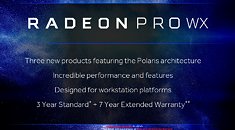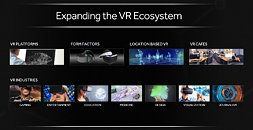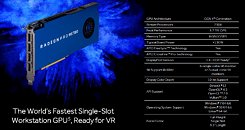Monday, November 7th 2016

AMD Reveals Three Entries on the WX Series Lineup: WX4100, WX5100 and WX7100
At its WX call, AMD focused on shifts in creativity from traditional design flows such as Solidworks, Adobe and Autodesk towards game engines as solutions for design visualization (Unreal Engine, Unity, CryEngine, or Autodesk's own Stingray platform), which signal changes in the creator ecosystem. Thanks to globalization, the Internet, and the available wealth of knowledge one can access through it, the line between amateurs and professionals is becoming more and more blurred. Now, those who would once be called amateurs are also using professional tools, and AMD plans to be at the forefront of technologies empowering creators to deliver their vision.
Radeon PRO serves to give creators more flexible and powerful solutions, leveraging open-source resources and centering the ecosystem back on creators and the tools they choose to use, with focused support on VR. As such, AMD is giving them the tools they need, by introducing three new products featuring the Polaris architecture, including 3 year standard + 7 year free extended warranty (including components such as the PCB itself, the PCI-Express slot, and the heatsinks), with AMD taking that extra 7 years as company commitment towards the quality of their products. Those three products are the WX4100, the WX5100, and the WX7100, and have planned, staggered availability throughout November.Under the hood, these products bring the Polaris GPU (through its Baffin and Ellesmere parts) into the professional workspace, leveraging 14nm FinFet, 4th Gen GCN, up to 5k HDR, Displayport 1.4, and True Audio Next support.The WX4100 brings an MSRP of $399, delivering up to 2.4 TFLOPS, up 1 TFLOP from AMD's equivalent previous-generation product it replaces in the stack. It features TDP under 50W, packing 1024 Stream processors and 8GB GDDR5 into a half-height bracket graphics card (with full height brackets also available). AMD says it's ready for all the typical workstation flows, but more specifically, CAD applications.The WX5100, on the other hand, comes in at $499, delivering up to 3.9 TFLOPS of computing power, at under 75 W power, which makes it slightly more efficient, in pure power/performance ratios, than the WX4100. AMD states that the WX5100 was developed to tackle all the traditional workflows, for professionals working with more resource-consuming models, equipping the WX5100 with a larger framebuffer, 1792 Stream Processors, and the same 8GB GDDR5 memory. This solution offers higher gaming engine environment performance than the WX4100 - Bioshock Infinite was benchmarked running at 53 FPS average @2560*1440, and an average of 35 FPS @ 4K.Finally, on to the latest and meanest member of the WX family that has been announced: the WX7100, which AMD touts as being the world's fastest single-slot workstation GPU, and one more geared towards VR workflows. This product enables the full Polaris 10 graphics chip, packing 2304 Stream Processors and 8GB GDDR5, with peak performance at 5.7 TFLOPS (AMD pointed towards its previous-generation, Fiji-based W9100, which delivered 5.24 TFLOPS as comparison). Another comparison points are the TDP, with the WX7100's standing at <130 W (less than half the <275 W on the W9100), and pricing: coming in at under 799$, the WX7100 stands as an upper middle-range product delivering more than the performance of previous-generation flagships, at 1/4 of the price (with the W9100 costing $3999 at launch, though it did offer an extra 8GB GDDR5 memory).
Source:
AMD
Radeon PRO serves to give creators more flexible and powerful solutions, leveraging open-source resources and centering the ecosystem back on creators and the tools they choose to use, with focused support on VR. As such, AMD is giving them the tools they need, by introducing three new products featuring the Polaris architecture, including 3 year standard + 7 year free extended warranty (including components such as the PCB itself, the PCI-Express slot, and the heatsinks), with AMD taking that extra 7 years as company commitment towards the quality of their products. Those three products are the WX4100, the WX5100, and the WX7100, and have planned, staggered availability throughout November.Under the hood, these products bring the Polaris GPU (through its Baffin and Ellesmere parts) into the professional workspace, leveraging 14nm FinFet, 4th Gen GCN, up to 5k HDR, Displayport 1.4, and True Audio Next support.The WX4100 brings an MSRP of $399, delivering up to 2.4 TFLOPS, up 1 TFLOP from AMD's equivalent previous-generation product it replaces in the stack. It features TDP under 50W, packing 1024 Stream processors and 8GB GDDR5 into a half-height bracket graphics card (with full height brackets also available). AMD says it's ready for all the typical workstation flows, but more specifically, CAD applications.The WX5100, on the other hand, comes in at $499, delivering up to 3.9 TFLOPS of computing power, at under 75 W power, which makes it slightly more efficient, in pure power/performance ratios, than the WX4100. AMD states that the WX5100 was developed to tackle all the traditional workflows, for professionals working with more resource-consuming models, equipping the WX5100 with a larger framebuffer, 1792 Stream Processors, and the same 8GB GDDR5 memory. This solution offers higher gaming engine environment performance than the WX4100 - Bioshock Infinite was benchmarked running at 53 FPS average @2560*1440, and an average of 35 FPS @ 4K.Finally, on to the latest and meanest member of the WX family that has been announced: the WX7100, which AMD touts as being the world's fastest single-slot workstation GPU, and one more geared towards VR workflows. This product enables the full Polaris 10 graphics chip, packing 2304 Stream Processors and 8GB GDDR5, with peak performance at 5.7 TFLOPS (AMD pointed towards its previous-generation, Fiji-based W9100, which delivered 5.24 TFLOPS as comparison). Another comparison points are the TDP, with the WX7100's standing at <130 W (less than half the <275 W on the W9100), and pricing: coming in at under 799$, the WX7100 stands as an upper middle-range product delivering more than the performance of previous-generation flagships, at 1/4 of the price (with the W9100 costing $3999 at launch, though it did offer an extra 8GB GDDR5 memory).










13 Comments on AMD Reveals Three Entries on the WX Series Lineup: WX4100, WX5100 and WX7100
I would also wager that game engines are currently the go-to resource towards visualizing VR content, and as such, AMD believes we'll see an eve greater focus on those in the future.
Mind you, it would be awesome to see plugin-esque integration of gameengines into modelling software or vise versa. Probably will happen at some point soon with VR picking up pace (and traditional path/ray traced software being as closed to realtime production as we are to colonizing Jupitor!)
AMD is saying that Zen-cpu's come in early 2017, then you could maybe get one in early 2018. The first AMD "Bristol Ridge"(AM4 socket) was released(by AMD standards) the 5'th of September this year, I haven't seen any tests, products or other indication that it was released in normal definition of the term, so AMD's definition maybe that the time between release and possible availability is a year or so.
I was an AMD "fanboy", stopped being that a couple of years ago, I still buy AMD(not Intel) but that may change very soon, a wait time of a year or 2 for a new product isn't soon, near soon or anything like that, think i have heard/read about AM4/Zen for 3, maybe 4 years, can no longer recall.
I am personally curious about the WX4100 basically what the RX460 should have been low profile, 50w and 1024 stream processors enabled. That needs to come out into the real market. Freaking AMD and their nonsense.